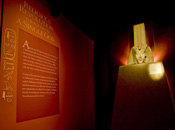
Tutankhamun and the Golden Age of the Pharaohs," now on view in
Among the most intriguing pieces from Tut’s tomb is a painted wooden torso of Tut. He may have been considered both a god and a human being, but the human dominates in this startlingly realistic bust, wearing a royal crown and linen shirt, but without arms. It projects a lively presence, but its purpose is one of the many mysteries still unanswered about Tut.
But the most impressive pieces are the many fine gold, personal items found with Tutankhamun’s mummy. The show’s grand finale consists of a replica of the mummy chamber with a handful of finely wrought, mostly gold objects -- a jeweled pectoral, made of gold, silver, glass and semiprecious stones, a gold diadem, and a gold knife and sheath too delicate for this world but perfect for use in a royal afterlife among others.
This is the second Tut exhibition to tour the
The King Tut shows are more than simple cultural exchanges, of course; they’re designed for fundraising as well, and this tour should help pay for a new museum to house antiquities in Cairo. Admission is $27.50 for adults.
In publicity for the show, there is a golden statue of King Tut that looks like the gilded funerary mask of King Tut’s mummy, which appeared in the last exhibition. The golden mask won’t leave
Tut’s liver caffeinate is made of gold, with inlays of colored glass and carnelian, and obsidian and rock crystal for his eyes. He holds a flail, symbol of royal power, and a crook, symbol of the king as shepherd of his people. It measures only about ten inches high, yet it exudes power.
One of the favorite pieces isn’t made of gold. It’s a carved-calcite cylindrical cosmetic jar with a recumbent lion, representing the king, on the lid. Instead of feet, the jar rests on four heads of traditional enemies of
For Tut enthusiasts, the Metropolitan Museum of Art is presenting a show of finds from the embalming site of Tut, "Tutankhamun’s Funeral," through Sept. 2, 2010. The small show has more artifacts than art but the importance of floral collars and the beads they incorporated are worth a look.
Reference: an article written by N.F. Karlins
